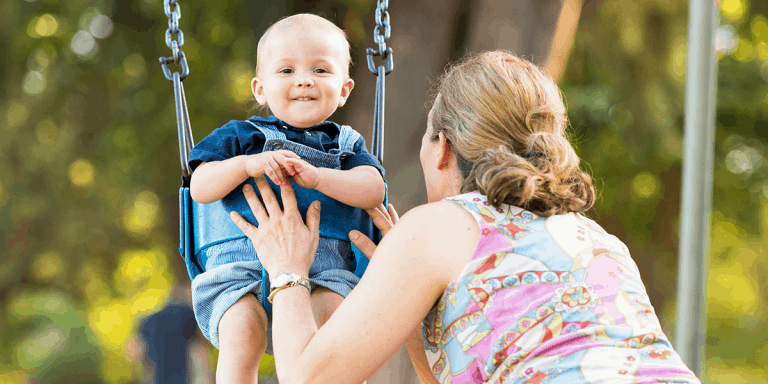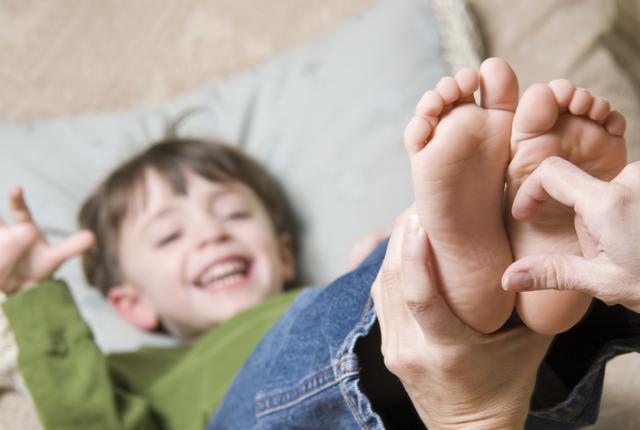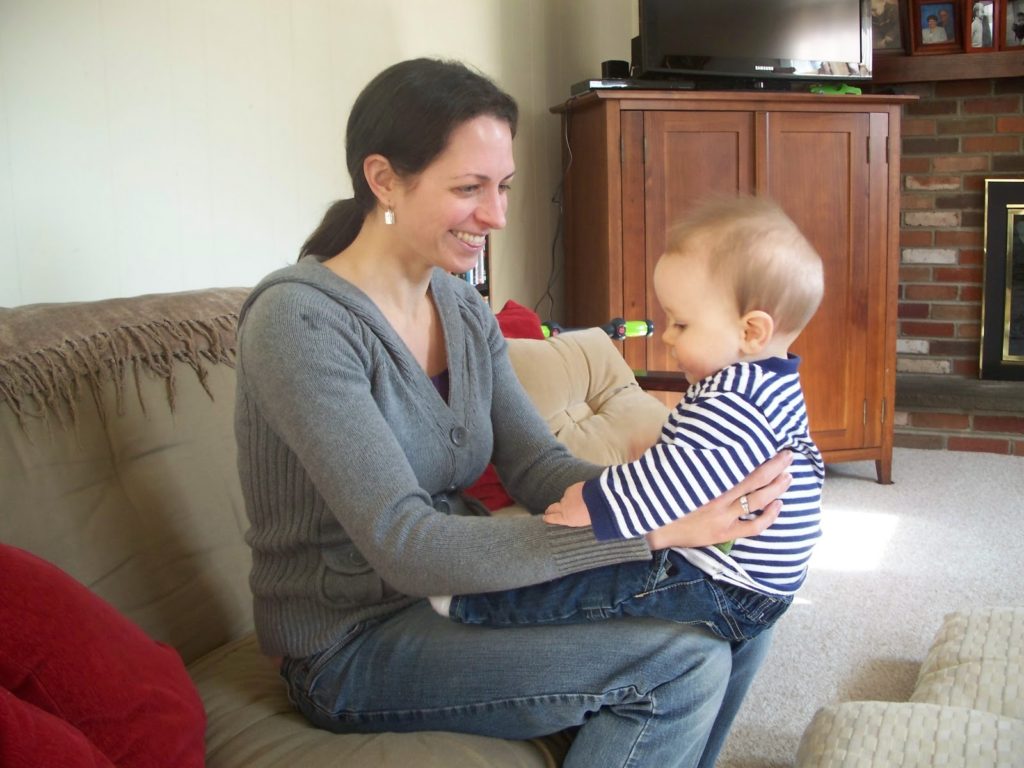Children learn so much by looking at our faces. At first they look because they enjoy our faces. Later, they look to see what we are looking at and what we think. This is called joint attention and provides an important foundation for language learning.
A child who is noticing where we are looking when we say a new word, will know what the word refers to. For children who are not looking as much, such as children with autism spectrum disorders, there are games that encourage them to enjoy and learn from looking.
- The key is to find something your child would enjoy over and over again. Start the fun thing, and then wait for your child to look at you before repeating.
- At first you might have to wait a very long time, but your patience will pay off. Your child will get the hang of it and you will find you are not waiting as long for the looks.
- It is very important not to tell your child to look at you. You’re waiting for your child to look at you because they are motivated to do so, not because they are told to do so. It is this natural motivation to look that we want to nurture. When we tell a child to look at us, we are not helping him learn to want to look at us.
- There are two different looks you might get during these activities. The first type is the look a child gives because something is really fun. Enjoy these looks and take the time to laugh together. These shared moments build a child’s understanding of the power and joy of interacting and communicating with people. The second type of look is when the child looks at you to see when the fun thing will happen again. This type of look is a powerful tool, because the child is looking at you for information. They are looking at you to learn about the world.
- As soon as your child looks at you, immediately say a meaningful word related to the activity and immediately engage in the action that the child is enjoying. For example, if your child is sitting on the swing and looks at you to see when you’ll give them the next push immediately say “Swing!” or “Push!” and give your child a push on the swing.
- Avoid praising your child for looking at you (e.g., “Great eye contact!” or “Good looking!”). There are several reasons why you want to avoid this type of praise:
- Your child’s looking is more likely to be reinforced by your actions (e.g., swinging your child), than by praise
- Your child will learn more from a meaningful word, such as “Push” or “Swing” while looking at you, than from praise. Modelling these types of words gives your child the opportunity to learn to say that word when you’re waiting for them to look at you.
- It sound pretty weird! 🙂
Games that Inspire Natural Eye Contact and Joint Attention
With all games below, it is important that your child feels comfortable with what you are doing. Be responsive to your child’s communication attempts, even if they’re non-verbal or unconventional. If your child shows you in any way that he/she is not enjoying the game, stop and try something different, or give your child some space if it seems that they want some time by themselves.
Swinging Games
- Blanket swing: In this game, the child lies on a blanket on the floor. Two adults pick up two corners of blanket each and swing the child. After a few swings, the adults stop swinging and wait for a look before swinging again.
- Swing: The child is sitting on a swing. The adult is facing the child and holding the swing up and forwards. Then the adult lets go and catches the swing when it comes back and waits for a look before letting go again.

- Swinging in parent’s arms. The parent swings the child, pauses, and waits for a look before continuing
Hug, Squish and Tickle Games
- In this game, the adult takes a pillow and squishes it gently on the child’s tummy one or two times and then waits for a look before repeating.
- Hot Dog: This is a good game for children who have a good verbal understanding and who enjoy silly games. In this game, the child is lying down. Using gestures with their hands, the adult can act out squirting on tomato sauce or mustard. They can also use tickles or pressure pushes on the child’s arms and legs while pretending to put on silly toppings like grass, mud, or anything else that your child might find hilarious. If your child is enjoying this game, you can pause and wait for your child to look at you between adding “toppings”
- Pigs in a blanket: The adult rolls the child up in a blanket, and then unrolls and waits for a look before repeating.
- Fish song: The adult sings, “1, 2, 3, 4, 5, once I caught a fish alive.” Next, the adult grabs the child in their arms and holds on. Then the adult sings “6, 7, 8, 9 10, then I let him go again,” and lets the child go. The adult waits for a look before starting again. Alternatively, if the child really enjoys being “caught”, then you could pause after saying “5” instead, and only “catch” the child after he or she makes eye contact.
- “I’m gonna get you”: Adult says, “I’m gonna get you” and chases, tickles, hugs the child, or picks the child up and spins him around. Adult waits for a look before repeating.
- Blow raspberries on hand, tummy or face. Stop, wait for eye contact before continuing.
- Tickle your child the way he or she likes to be tickled. Stop and wait for a look before continuing. Remember these rules for tickling:
- Laughing in response to tickling is a physiological response and not necessarily a sign that your child is definitely enjoying this interaction
- Keep tickles short and wait for your child to show you they want more tickles before continuing
- Aside from looking, give your child frequent opportunities to communicate that they want more tickles in other ways, for example by approaching you, moving their foot or arm or tummy in your directions, moving your hand to where they want to be tickled, or by saying “tickle.” If they’re not showing you these signs, try a different game.

- Round and round the garden like a teddy bear (circling your finger on your child’s hand), 1 step, 2 step (take “steps” with your fingers up your child’s arm)…. Pause for eye contact…. Tickle you under there! (tickle child’s armpit or neck).
Spinning
Child sits in a computer chair that spins. Adult spins the chair, stops the chair and waits for eye contact before spinning again
Funny Noises
Make a noise your child enjoys once or twice, and then wait for a look before repeating. Examples:
- Fill your mouth with air and pop your cheeks
- Sneeze
- Trill your tongue
- Smack your lips
Bouncing Games
Bounce child on lap. Pause and wait for a look before continuing. The following songs are all great songs to add to this activity.
- Smooth Road to London Town
- The Grand Old Duke of York
- This is the way the ladies ride

Songs and Rhymes
In any of your child’s favourite songs, pause partway through and wait for a look before continuing. These songs work well:
- Row row row your boat
- Raise hand up while saying: “Pitter patter pitter patter pitter patter”. . . (wait for a look), bring hands down, saying “Boom”
- Zoom, zoom, zoom, we’re going to the moon (pause at the end of the countdown, before you lift the child up in the air)
- If you’re not familiar with these songs, you can look them up on Youtube.
Walking and Running Games:
- Crash: Take child’s hand and run and crash onto a sofa or into a big bean bag chair. Enjoy the moment together, walk back and wait for eye contact before running to crash again.
- Go go stop: Say “Go” and run with child for a while. Say “Stop” and stop running. Wait for eye contact before saying, “go” and running again.
- Puddle jumping: Put out mats or foam in a row and pretend they are puddles. Take a step together to the first “puddle” and then make a big fuss about how your feet are all wet – be funny about this! Then stop, lift up your leg as if to step into the next puddle but wait for eye contact before stepping together to the second “puddle”.
Games with Toys
In games with toys, you can wait for eye contact before you take your own turn, and/or you can wait for eye contact before passing back the toy or passing the next toy. If your child needs help to make a toy “go,” then you can pause for eye contact before making the toy work (e.g., bubbles, spinning tops, balloons).
- Turn taking games: Pop up pirate, marble run, any “ready steady go” game, here comes the ball, zig zag racers, bubbles
- Bubbles
- Wind up toys
- Spinning tops
- Toys in a bag (cars, puzzle pieces, alphabet letters)
- Tunnel
- Balloons
- Paper airplanes
- Popper tubes
- Crash the blocks
Do you have any other games that your child likes to play and that are great for promoting eye contact and joint attention? Please comment below with your ideas!


hi there, your style is very good.Following your articles.